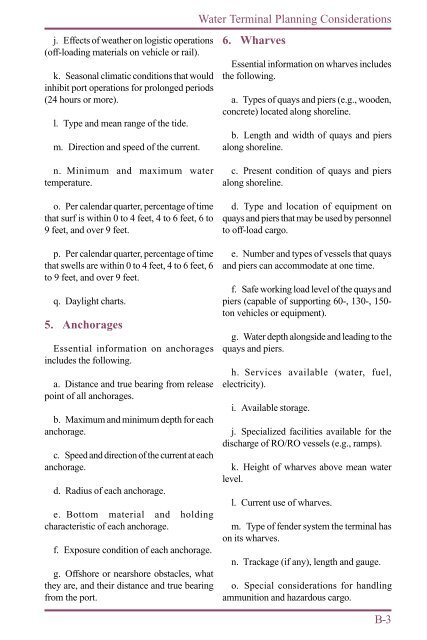JP 4-01.5 JTTP for Water Terminal Operations - BITS
JP 4-01.5 JTTP for Water Terminal Operations - BITS
JP 4-01.5 JTTP for Water Terminal Operations - BITS
Create successful ePaper yourself
Turn your PDF publications into a flip-book with our unique Google optimized e-Paper software.
j. Effects of weather on logistic operations<br />
(off-loading materials on vehicle or rail).<br />
k. Seasonal climatic conditions that would<br />
inhibit port operations <strong>for</strong> prolonged periods<br />
(24 hours or more).<br />
l. Type and mean range of the tide.<br />
m. Direction and speed of the current.<br />
n. Minimum and maximum water<br />
temperature.<br />
o. Per calendar quarter, percentage of time<br />
that surf is within 0 to 4 feet, 4 to 6 feet, 6 to<br />
9 feet, and over 9 feet.<br />
p. Per calendar quarter, percentage of time<br />
that swells are within 0 to 4 feet, 4 to 6 feet, 6<br />
to 9 feet, and over 9 feet.<br />
q. Daylight charts.<br />
5. Anchorages<br />
Essential in<strong>for</strong>mation on anchorages<br />
includes the following.<br />
a. Distance and true bearing from release<br />
point of all anchorages.<br />
b. Maximum and minimum depth <strong>for</strong> each<br />
anchorage.<br />
c. Speed and direction of the current at each<br />
anchorage.<br />
d. Radius of each anchorage.<br />
e. Bottom material and holding<br />
characteristic of each anchorage.<br />
f. Exposure condition of each anchorage.<br />
g. Offshore or nearshore obstacles, what<br />
they are, and their distance and true bearing<br />
from the port.<br />
<strong>Water</strong> <strong>Terminal</strong> Planning Considerations<br />
6. Wharves<br />
Essential in<strong>for</strong>mation on wharves includes<br />
the following.<br />
a. Types of quays and piers (e.g., wooden,<br />
concrete) located along shoreline.<br />
b. Length and width of quays and piers<br />
along shoreline.<br />
c. Present condition of quays and piers<br />
along shoreline.<br />
d. Type and location of equipment on<br />
quays and piers that may be used by personnel<br />
to off-load cargo.<br />
e. Number and types of vessels that quays<br />
and piers can accommodate at one time.<br />
f. Safe working load level of the quays and<br />
piers (capable of supporting 60-, 130-, 150ton<br />
vehicles or equipment).<br />
g. <strong>Water</strong> depth alongside and leading to the<br />
quays and piers.<br />
h. Services available (water, fuel,<br />
electricity).<br />
i. Available storage.<br />
j. Specialized facilities available <strong>for</strong> the<br />
discharge of RO/RO vessels (e.g., ramps).<br />
k. Height of wharves above mean water<br />
level.<br />
l. Current use of wharves.<br />
m. Type of fender system the terminal has<br />
on its wharves.<br />
n. Trackage (if any), length and gauge.<br />
o. Special considerations <strong>for</strong> handling<br />
ammunition and hazardous cargo.<br />
B-3
















